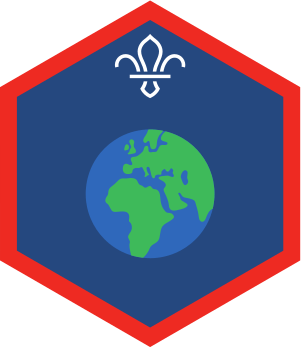
Make a difference with Scouts all over the world
You’ll need
- Device with access to the internet
Staying safe online
This activity’s designed for you to run during an online session. Take a look at our advice on using Zoom and other popular digital platforms, as well as guidance to help everyone to stay safe online.
Make sure that the person leading the game is the meeting host and that they know how to use the waiting room function on Zoom – there’s more information on the Zoom blog.
Before you begin
- Use the safety checklist to help you plan and risk assess your activity. Additional help to carry out your risk assessment, including examples can be found here. Don’t forget to make sure all young people and adults involved in the activity know how to take part safely.
- Make sure you’ll have enough adult helpers. You may need some parents and carers to help if you’re short on helpers
Planning the meeting
- Arrange to make contact with Scouts from another country. There are lots of ways to get in touch with Scouts in other countries. There’s guidance on the international links here.
- Explain that Jamboree on the Air and Jamboree on the Internet (JOTA JOTI) is an event specially designed to connect Scouts all over the world – it usually happens in October each year.
- Everyone should chat about how they’ll act when the groups speak. They might want to think about how they can be friendly, for example, how they’ll introduce themselves and get to know a bit about the other group too.
- This is a great time to remind people about staying safe online and not sharing personal information. If they’re uncomfortable or unsure about anything, they should chat to a trusted adult.
- Everyone should look at the UN Sustainable Development Goals and what Scouts are doing to work towards them.
- Everyone should decide which ones they may be interested in working towards with the Scouts from another country.
Change the world together
- Confirm the details with the leader of the other group. They may need to work together to plan the session.
- When the groups speak, they should start by introducing themselves and answering each other’s questions. What would people like to know about how Scouts works in another country?
- Once everyone’s got to know each other a bit, they should explore the action they’ll take to help their country (and the world) to reach the goal.
- We’ve included some suggestions below, but it’s up to you which goal you pick and how you take action.
Suggestions for sustainable development goals
Target 13.1 is ‘Strengthen resilience and adaptive capacity to climate-related disasters’.
- Each group should take it in turns to explain what natural disasters occur where they live. For example, forest fires, earthquakes, tornadoes, flooding and storms. It’s up to you whether you talk about your whole country, or just your region.
- Everyone should see if there are any natural disasters the groups have in common. If they do, do they experience them in similar ways? What’s it like when one happens? If they don’t have any in common, people may have lots of questions about people in the other group’s experiences.
- Everyone should take it in turns to explain how the natural disasters affect life and the natural world. For example, what does it do to animals’ habitats and biodiversity?
- Everyone should take it in turns to explain what their communities do to prepare for (or deal with) the disasters they experience. For example, communities that experience floods may work hard to maintain ditches and drainage systems, build flood defences and early warning systems, and reassess where and how they build their houses.
- Each group should think about what they could do to help. Do they do anything already? For example, some groups may volunteer to help with clearing up after disasters, or volunteer to prepare defences and early warning systems.
- Everyone should challenge each other to take action and make a difference.
- If possible, the groups should keep in touch and check back in on each other’s progress towards the Sustainable Development Goals.
Target 15.2 is ‘End deforestation and restore degraded forests’. Trees are one of the most important parts of the ecosystem on land, but many are cut down or damaged because of human activity and natural disasters.
- Everyone should take it in turns to talk about the trees where they live. What sort grow, and what makes them special? For example, people might talk about how trees produce fruit, give animals homes, or hold riverbanks together.
- Everyone should talk about the deforestation that occurs where they live. What are the causes? If there isn’t much deforestation, why?
- Everyone should share some pictures of trees from their country (or near where they live). Do the pictures show any damage?
- Everyone should think about how they could help by planting or protecting trees. They should challenge each other to take action and make a difference. There may be schemes for planting or celebrating trees, for example, the tree of the year award (see if you can spot the Gilwell Oak in the 2018 entries) and the Woodland Trust has help for large scale planting.
- If possible, the groups should keep in touch and check back in on each other’s progress towards the Sustainable Development Goals.
Reflection
This activity was all about being a local, national, and international citizen. People connected with Scouts from another country. Were there similarities between their experiences of being a Scout? What was the same about Scouts in both places? What was different? Both groups worked towards the same Sustainable Development Goal, despite being far apart. Why might it be easier to focus on changing things in a local community? What would happen if enough people took action in their local community? The local actions would add up to international change.
This activity was also about communicating. Communicating across borders can be a rewarding challenge, especially if there are language barriers. What was different about communicating through technology? People might think about how eye contact was different (if they’re usually comfortable making eye contact), how you couldn’t see as much of people’s body language, or how any delays made it trickier. What are the benefits of communicating through technology?
Safety
All activities must be safely managed. You must complete a thorough risk assessment and take appropriate steps to reduce risk. Use the safety checklist to help you plan and risk assess your activity. Always get approval for the activity, and have suitable supervision and an InTouch process.
- Online safety
Supervise young people when they’re online and give them advice about staying safe. Take a look at our online safety or bullying guidance. The NSPCC offers more advice and guidance, too. If you want to know more about specific social networks and games, Childnet has information and safety tips for apps. You can also report anything that’s worried you online to the Child Exploitation and Online Protection Command. As always, if you’ve got concerns about a young person’s welfare, including their online experiences, follow the Yellow Card to make a report.
People can communicate however works best for them – some people may want to do a lot of the speaking, while others may want to draw or type (if the platform you’re using allows).
All Scout activities should be inclusive and accessible.
Why not do more to make the world the better place by focusing on one of the Sustainable Development Goals. You could plan a whole campaign in your area to support the SDGs, it could even be part of your Community Impact Staged Activity Badge.


